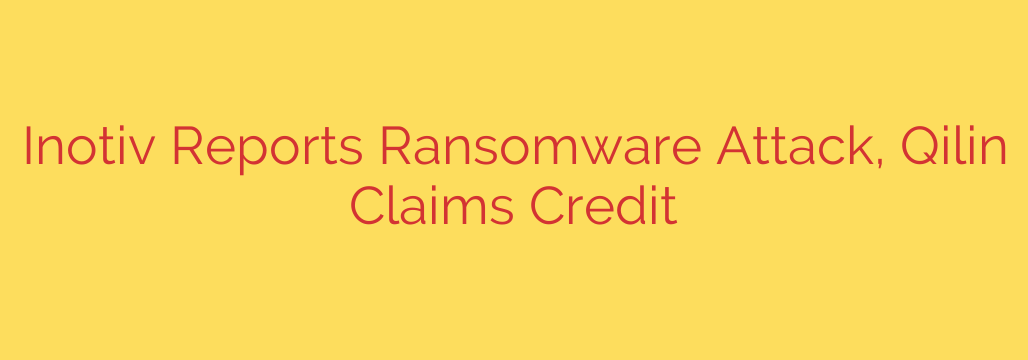
Major Research Firm Inotiv Targeted in Sophisticated Ransomware Attack by Qilin Group
In a stark reminder of the persistent cyber threats facing the life sciences sector, Inotiv, a leading contract research organization (CRO), has confirmed it was the victim of a significant ransomware attack. The incident, which has caused notable business disruption, highlights the vulnerability of organizations that handle sensitive intellectual property and critical research data.
The cyberattack was detected in early April, prompting an immediate and robust response from the company. To contain the threat and protect its digital infrastructure, Inotiv took certain systems offline and launched a comprehensive investigation. The company has also engaged the services of third-party cybersecurity experts to assist with remediation and has notified law enforcement agencies.
The financial and operational impact of the attack was significant enough for Inotiv to file a Form 8-K with the U.S. Securities and Exchange Commission (SEC). This type of filing is reserved for unscheduled material events or corporate changes that are important to shareholders, underscoring the severity of the incident. Following the disclosure, the company’s stock experienced a noticeable decline, reflecting investor concern over the operational and financial fallout.
The Culprits: Who is the Qilin Ransomware Group?
The notorious Qilin ransomware group has publicly claimed responsibility for the attack on Inotiv. Qilin operates on a Ransomware-as-a-Service (RaaS) model, developing malicious software and then licensing it to affiliate hackers in exchange for a percentage of the ransom payments.
This group is known for its aggressive tactics and its focus on targeting critical infrastructure, healthcare, and manufacturing sectors. Their typical method of attack involves:
- Initial Access: Gaining a foothold in a network through phishing emails or by exploiting known software vulnerabilities.
- Data Exfiltration: Quietly stealing large volumes of sensitive data before deploying the ransomware.
- Encryption and Extortion: Encrypting the victim’s files to paralyze operations and then demanding a ransom for the decryption key. They often use a double-extortion tactic, threatening to publicly leak the stolen data if the ransom is not paid.
Qilin’s history shows a pattern of targeting high-value organizations where operational downtime and data exposure can cause maximum damage, thereby increasing their leverage for a large payout.
Why the Life Sciences Sector is a Prime Target
Contract research organizations, pharmaceutical companies, and biotech firms like Inotiv are increasingly in the crosshairs of cybercriminals. These organizations are treasure troves of valuable information, including:
- Proprietary drug formulas and research data
- Clinical trial results and patient information
- Patents and other forms of intellectual property
The theft or disruption of this data can not only lead to immense financial loss but also derail years of research and development, providing a powerful incentive for victims to pay a ransom.
Actionable Steps to Defend Against Ransomware
This attack serves as a critical warning for all organizations, especially those in the research and healthcare fields. Proactive defense is the best strategy. Here are essential security measures every organization should implement:
Strengthen Access Controls: Implement Multi-Factor Authentication (MFA) across all critical systems, including email, VPNs, and administrative accounts. This adds a crucial layer of security beyond just a password.
Conduct Regular Employee Training: Your staff is your first line of defense. Provide ongoing training to help them recognize and report phishing attempts, which remain a primary entry point for attackers.
Prioritize Patch Management: Cybercriminals frequently exploit known vulnerabilities in software. Maintain a rigorous schedule for patching and updating all systems, prioritizing critical vulnerabilities as soon as fixes are available.
Implement Network Segmentation: By dividing your network into smaller, isolated segments, you can limit the lateral movement of an attacker. If one part of the network is compromised, segmentation can prevent the threat from spreading to critical data repositories.
Develop a Robust Backup and Recovery Plan: Maintain regularly tested, offline, and immutable backups of your most critical data. A reliable backup strategy ensures you can restore operations without being forced to pay a ransom.
The attack on Inotiv is a sobering development that underscores the evolving landscape of cyber threats. As attackers become more sophisticated, organizations must adopt a resilient and multi-layered security posture to protect their invaluable data and ensure business continuity.
Source: https://securityaffairs.com/181311/data-breach/pharmaceutical-firm-inotiv-discloses-ransomware-attack-qilin-group-claims-responsibility-for-the-hack.html








